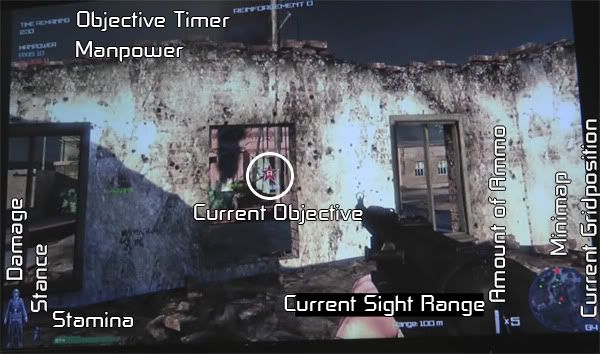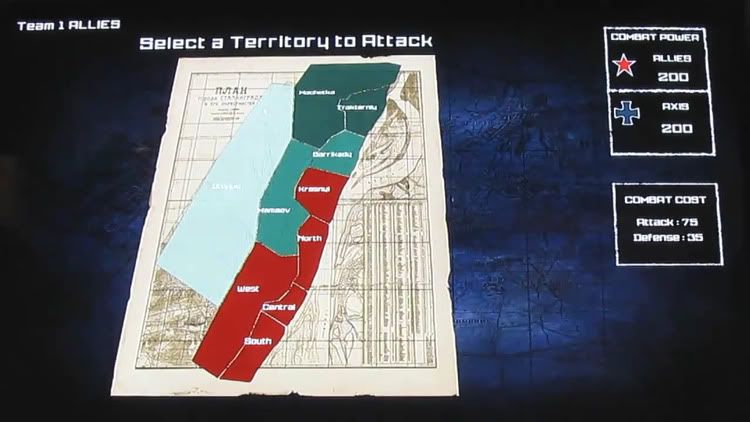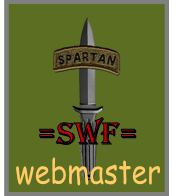Post by swfwebmaster on Dec 21, 2011 20:39:18 GMT 1
This was originally posted by =SWF=wobblyone

• First Person Cover System: Players can take cover behind objects in first person and easily peek or blind fire over and around cover and more.
• Squad Command: Players can command fire teams on the battlefield with an easy to use first person interface.
• Damage System: A detailed hit detection system. Specific bodyparts hit are more lethal than others. Instant Death, Lethal, Critical and Non-Critical.
• Mantling System: Players can negotiate low obstacles, such as climbing over fences, through windows, etc.
• Adjustable Sights: Iron sights as well as scopes on weapons are adjustable for longer and shorter ranges.
• Bandaging: Players can bandage minor wounds to stop themselves from bleeding to death. Non-critical hits will cause half the damage instantly, with the other half occurring over bleed out time. Prompt bandaging can stop the second half of the damage from occurring.
• Interactive Weapon Collision: Weapons collide with the game world; the player will raise and lower his weapon accordingly.
• Bullet Penetration: Bullets can penetrate some materials and cause damage on the other side.
• Breathing System: The player's breathing pattern will affect his aim; players can hold their breath momentarily for a more stable shot. Players who have low stamina from sprinting, etc. will breathe harder.
• Bipods: Bipod mounted weapons will pivot around their bipods when deployed. Deploying bipod mounted weapons is much easier than it was in Ostfront.
• Tactical View: HUD elements appear as the player needs them, and are automatically hidden when the player does not. The entire HUD can be brought up at any time with the press of a key.
• Weight System: The player can carry multiple weapons as well as grenades, but has a maximum allowed weight and will slow down as they carry more.
• Peripheral Vision Indicators: Small indicators appear at the edge of the player's screen to denote possible enemies in the player's peripheral vision.
• Mini-map: The mini-map shows you friendly players, and where your squad mates/squad leaders are.
• Dynamic Music System: Heroes of Stalingrad features a dynamic music system that adapts the emotional mood of the soundtrack to match the morale of the player based on the flow of the battle. To highlight the differences between the two warring powers the game features a completely unique soundtrack for the Russian and German sides.
• New Recoil Model: The recoil model is more realistic than that of Ostfront. SMG's have had their recoil lowered and MG's have more recoil.
• Interruptible Reloads: Reloads can now be interrupted.
• Fire Support: There are 3 types of fire support: mortars, artillery, and rockets. Mortars cause a small amount of damage in a small area, rockets cause a large amount of damage over a large area. Artillery falls in between.
• Aerial Recon: The commander can call a recon plane which surveys the battlefield and reports enemy positions. Enemy infantry and tanks will show up on the commander's map instantly (as long as he is near the radio), and will filter down the ranks with a few seconds delay. The plane will only report units it has actual visual contact with; it will be possible to hide from it and shoot it down.
• Ironsights for the Sniper: Sniper rifles now have usable ironsights, as they did in real life.
• Destructable Buildings: Any and all buildings are destructible if the mapper wants. Buildings will still leave ruins behind, however, so the battlefield isn't bombed flat.
• SDK: The game ships with SDK and a Mapping Tool out of the box.

• Virtual Interior: The entire interior of the tanks is modeled, with useable hatches, periscopes, viewports, etc.
• Tank Locking: Tank commanders can choose to lock their tanks or allow other players to join their crew.
• New Tank Damage System: Heroes of Stalingrad has a significantly more complex damage system than Ostfront. Damage to systems such as optics, engine, transmission, turret rotation mechanism, fuel tank, drive sprocket, treads and more are modelled. Shots that penetrate the tank's armor can kill crewmembers inside. Crewmembers have individual hitboxes within the tank and are killable via penetration of an AT rifle round.
• Squad Tank Crew (AI/Human): All tanks will have a full crew; any playable positions that are not filled by a human player will be filled by AI.
• Squad Dynamic tank class system: There will be one tank commander class slot for each tank; as commanders choose to allow human players in their tanks, tank crew class slots will dynamically open up. This means that players don't have to make a choice between having more tanks with solo tanking or fewer with team tanking.

• Character Progression: Players can gain experience and rank. Higher ranked players have access to rare weapons, equipment and classes. Higher ranked players are visually distinct from lower ranked players. If you do poorly, for example tk a lot you can rank down.
• Persistent Stats Tracking and Player Progression: Persistence constantly gives the gamer something to strive for and keeps them playing. Grow in rank, earn medals, improve your abilities, and become a Hero – all visible to the complete online gaming community and embedded within the game.
• Heroes: Obtain the ultimate goal and become a Hero online. Players with hero status inspire troops around them and cause fear in their enemies. Heroes have access to the best and rarest weapons and equipment, and will stand out visually from the rest of the soldiers.
• Competitions & Leader-boards: Compete to obtain unique awards and achievements with players all over the world. The competitions range from shooting range challenges to unique and fun assault courses.
• Battlefield Commissions: Low ranked players can earn a promotion by performing well, and get to choose higher ranked classes. This is a temporary ingame commission.

Server Options
• Co-op: Players can connect with their friends and battle AI in multiple game types including the Stalingrad Campaign, Skirmish Mode, and more.
• 64 Player Support: They are shooting to max out players in a game at 64 (large maps) and there are ten maps in the game already.
• Realism Settings: 2 Settings. Relaxed Realism and Realistic. Relaxed realism will include all of the new interface helpers. Realistic will be for the more hardcore players, and will have some of the new interface helpers disabled. Server admins will be able to set up a custom configuration that picks and chooses which features to have.
• Custom Server Configs: Server configs are customizable, can be shared, and can even be rated by others.
• RO TV 2.0: RO TV makes a comeback making it possible to spectate (clan) matches.
• Death messages: 3 Death message settings. Normal, Delayed, and Off. Death messages also display distance for your own personal kills.
• Server Class Lock: Some classes are locked until a certain amount of players join the server.

Gameplay Modes
• Territory Mode: This is the original gamemode that made Red Orchestra famous. Attack, Hold and Defend objectives within the set timelimit, or until one side runs out of reinforments.
• Countdown Mode: Countdown mode is a single life gametype that is governed by a short countdown timer. Players will have to attack or defend a series of objectives, but with only one life per objective. If the attackers capture the objective, all players respawn and move to the next objective. If they do not capture the objective before the timer expires, they lose. Maps will have "key objectives" which when taken will allow the attacking team a single respawn on a later failed capture.
• Firefight Mode: Red Orchestra's version of team deathmatch.
• Multiplayer Campaign Mode: The campaign map is divided into 10 smaller maps. The players vote which map to attack, and can decide how much of their Combat Power they want to use on the attack. Each campaign can last a maximum of 4 hours.
• Co-op Campaign Mode: The singleplayer campaign can be played with a friend/friends.
• Skirmish Mode: This mode can be played online and offline. You get three fire teams of three members each. Fire team members can be made up of human players or AI. The goal is to 'clear' the map of enemy AI. It can be compared to Terrorist Hunt mode in the Rainbow Six games.

• First Person Cover System: Players can take cover behind objects in first person and easily peek or blind fire over and around cover and more.
• Squad Command: Players can command fire teams on the battlefield with an easy to use first person interface.
• Damage System: A detailed hit detection system. Specific bodyparts hit are more lethal than others. Instant Death, Lethal, Critical and Non-Critical.
• Mantling System: Players can negotiate low obstacles, such as climbing over fences, through windows, etc.
• Adjustable Sights: Iron sights as well as scopes on weapons are adjustable for longer and shorter ranges.
• Bandaging: Players can bandage minor wounds to stop themselves from bleeding to death. Non-critical hits will cause half the damage instantly, with the other half occurring over bleed out time. Prompt bandaging can stop the second half of the damage from occurring.
• Interactive Weapon Collision: Weapons collide with the game world; the player will raise and lower his weapon accordingly.
• Bullet Penetration: Bullets can penetrate some materials and cause damage on the other side.
• Breathing System: The player's breathing pattern will affect his aim; players can hold their breath momentarily for a more stable shot. Players who have low stamina from sprinting, etc. will breathe harder.
• Bipods: Bipod mounted weapons will pivot around their bipods when deployed. Deploying bipod mounted weapons is much easier than it was in Ostfront.
• Tactical View: HUD elements appear as the player needs them, and are automatically hidden when the player does not. The entire HUD can be brought up at any time with the press of a key.
• Weight System: The player can carry multiple weapons as well as grenades, but has a maximum allowed weight and will slow down as they carry more.
• Peripheral Vision Indicators: Small indicators appear at the edge of the player's screen to denote possible enemies in the player's peripheral vision.
• Mini-map: The mini-map shows you friendly players, and where your squad mates/squad leaders are.
• Dynamic Music System: Heroes of Stalingrad features a dynamic music system that adapts the emotional mood of the soundtrack to match the morale of the player based on the flow of the battle. To highlight the differences between the two warring powers the game features a completely unique soundtrack for the Russian and German sides.
• New Recoil Model: The recoil model is more realistic than that of Ostfront. SMG's have had their recoil lowered and MG's have more recoil.
• Interruptible Reloads: Reloads can now be interrupted.
• Fire Support: There are 3 types of fire support: mortars, artillery, and rockets. Mortars cause a small amount of damage in a small area, rockets cause a large amount of damage over a large area. Artillery falls in between.
• Aerial Recon: The commander can call a recon plane which surveys the battlefield and reports enemy positions. Enemy infantry and tanks will show up on the commander's map instantly (as long as he is near the radio), and will filter down the ranks with a few seconds delay. The plane will only report units it has actual visual contact with; it will be possible to hide from it and shoot it down.
• Ironsights for the Sniper: Sniper rifles now have usable ironsights, as they did in real life.
• Destructable Buildings: Any and all buildings are destructible if the mapper wants. Buildings will still leave ruins behind, however, so the battlefield isn't bombed flat.
• SDK: The game ships with SDK and a Mapping Tool out of the box.

• Virtual Interior: The entire interior of the tanks is modeled, with useable hatches, periscopes, viewports, etc.
• Tank Locking: Tank commanders can choose to lock their tanks or allow other players to join their crew.
• New Tank Damage System: Heroes of Stalingrad has a significantly more complex damage system than Ostfront. Damage to systems such as optics, engine, transmission, turret rotation mechanism, fuel tank, drive sprocket, treads and more are modelled. Shots that penetrate the tank's armor can kill crewmembers inside. Crewmembers have individual hitboxes within the tank and are killable via penetration of an AT rifle round.
• Squad Tank Crew (AI/Human): All tanks will have a full crew; any playable positions that are not filled by a human player will be filled by AI.
• Squad Dynamic tank class system: There will be one tank commander class slot for each tank; as commanders choose to allow human players in their tanks, tank crew class slots will dynamically open up. This means that players don't have to make a choice between having more tanks with solo tanking or fewer with team tanking.

• Character Progression: Players can gain experience and rank. Higher ranked players have access to rare weapons, equipment and classes. Higher ranked players are visually distinct from lower ranked players. If you do poorly, for example tk a lot you can rank down.
• Persistent Stats Tracking and Player Progression: Persistence constantly gives the gamer something to strive for and keeps them playing. Grow in rank, earn medals, improve your abilities, and become a Hero – all visible to the complete online gaming community and embedded within the game.
• Heroes: Obtain the ultimate goal and become a Hero online. Players with hero status inspire troops around them and cause fear in their enemies. Heroes have access to the best and rarest weapons and equipment, and will stand out visually from the rest of the soldiers.
• Competitions & Leader-boards: Compete to obtain unique awards and achievements with players all over the world. The competitions range from shooting range challenges to unique and fun assault courses.
• Battlefield Commissions: Low ranked players can earn a promotion by performing well, and get to choose higher ranked classes. This is a temporary ingame commission.

Server Options
• Co-op: Players can connect with their friends and battle AI in multiple game types including the Stalingrad Campaign, Skirmish Mode, and more.
• 64 Player Support: They are shooting to max out players in a game at 64 (large maps) and there are ten maps in the game already.
• Realism Settings: 2 Settings. Relaxed Realism and Realistic. Relaxed realism will include all of the new interface helpers. Realistic will be for the more hardcore players, and will have some of the new interface helpers disabled. Server admins will be able to set up a custom configuration that picks and chooses which features to have.
• Custom Server Configs: Server configs are customizable, can be shared, and can even be rated by others.
• RO TV 2.0: RO TV makes a comeback making it possible to spectate (clan) matches.
• Death messages: 3 Death message settings. Normal, Delayed, and Off. Death messages also display distance for your own personal kills.
• Server Class Lock: Some classes are locked until a certain amount of players join the server.

Gameplay Modes
• Territory Mode: This is the original gamemode that made Red Orchestra famous. Attack, Hold and Defend objectives within the set timelimit, or until one side runs out of reinforments.
• Countdown Mode: Countdown mode is a single life gametype that is governed by a short countdown timer. Players will have to attack or defend a series of objectives, but with only one life per objective. If the attackers capture the objective, all players respawn and move to the next objective. If they do not capture the objective before the timer expires, they lose. Maps will have "key objectives" which when taken will allow the attacking team a single respawn on a later failed capture.
• Firefight Mode: Red Orchestra's version of team deathmatch.
• Multiplayer Campaign Mode: The campaign map is divided into 10 smaller maps. The players vote which map to attack, and can decide how much of their Combat Power they want to use on the attack. Each campaign can last a maximum of 4 hours.
• Co-op Campaign Mode: The singleplayer campaign can be played with a friend/friends.
• Skirmish Mode: This mode can be played online and offline. You get three fire teams of three members each. Fire team members can be made up of human players or AI. The goal is to 'clear' the map of enemy AI. It can be compared to Terrorist Hunt mode in the Rainbow Six games.







